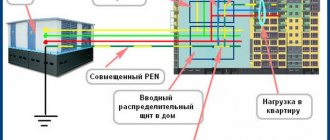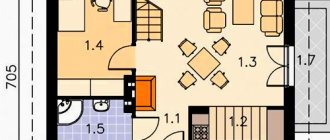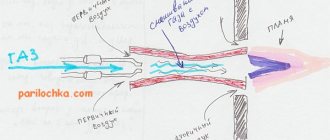How to determine phase and zero on a chandelier
To properly connect any household appliances in the house, it is important to understand and correctly determine the purpose of each wire to which you should connect an outlet, switch, hang lamps or a chandelier, etc. For professional electricians, it will not be difficult to understand this simple task. But for ordinary homeowners, the problem can be quite noticeable. Especially if you consider, for example, that when connecting a multi-arm chandelier with the ability to select the number of lamps to be switched on, you need to connect several wires.
How does the home electrical network work?
The vast majority of modern apartments are equipped with a single-phase power supply network with a voltage of 220V and a frequency of 50Hz. A fairly powerful three-phase line is supplied directly to the house itself, but then one phase and one neutral wire are sent to each apartment through distribution boards. The task of electricians at this stage is to ensure the most efficient and uniform distribution so that there are no severe distortions during everyday operation.
Features of installing lighting with a suspended ceiling
The tension structure is a thin sheet of PVC film or synthetic fabric that will not support the weight of lighting fixtures. That's why they don't hang anything on it. The lamps are secured using embedded platforms, which are installed before the ceiling is stretched.
The platform is screwed to the rough ceiling on hangers and placed flush with the finishing surface. After stretching the ceiling, a hole is cut out in the canvas and spotlights are installed, attaching them to the embedded platform. Chandeliers are mounted in a similar way.
PVC film melts at high temperatures, and diverges when cut. Therefore, the places where there should be holes or fasteners are pre-strengthened. To do this, use thermal rings that protect the film from rupture and overheating. For small holes for self-tapping screws, reinforced tape is suitable.
This feature is also taken into account when choosing lighting. With PVC film, you cannot use incandescent lamps with a power higher than 60 W, and halogen lamps - 40 W. It is best to take LED ones, which practically do not heat up and last a long time.
When installing incandescent lamps, chandeliers are selected with closed shades, and the distance to the canvas should be at least 30 cm.
With a glossy ceiling, it is better to choose horns pointing down to avoid unnecessary glare. The matte canvas does not reflect, so any options are possible. The base of the chandelier or lamps should be without sharp corners so as not to damage the material.
Lighting in a room with suspended ceilings is also subject to general laws. Designers distinguish three main types:
- Reflected . It is created due to refraction from the plane, so it turns out softer and more uniform, comfortable for the eyes. Used as main lighting in living rooms and bedrooms.
- Accent . Bright and concentrated, draws attention to some detail. But at the same time it is very blinding, which is why it is used with caution. For example, they highlight a painting, photograph or other valuable piece of furniture. It is better to place it so that the source is not visible, then it hurts the eyes less.
- Directed . Creates additional illumination in the place where it is needed. For example, in the area for cooking and washing dishes in the kitchen or for reading in the living room, bedroom and children's room.
Let's look at how these tasks are performed using different types of lighting fixtures.
Various options
There are many methods and options for how to determine the neutral wire on a chandelier when performing work to connect it to the electrical wiring in the house. Each user, home master, and even more so a specialist, usually chooses for himself one of the most convenient methods and uses it in everyday life. Often the choice is made taking into account the presence or absence of certain measuring (control) devices. And if professional electricians have plenty of such “goodness” with them, then the average homeowner will have a limited choice of devices (and with them, methods for determining zero or phase).
It is worth considering briefly all existing methods, and only then each user will be able to determine the best option for themselves.
Types of connection
If the lamp has two wires, the chandelier is simply connected to phase and neutral. In this case, it does not matter where each core will be connected. Two phases can also come out of the ceiling when a two-button switch is installed. In this case, the conductors are combined and then connected to one of the wires of the lamp. This option will allow you to turn on the chandelier with any key, and turn it off with two at once. You can also insulate one phase and connect the second to the lamp wire. With this design, the light will turn on exclusively with one switch button.
Connection to a single switch
Do-it-yourself installation of a chandelier is greatly simplified if two wires come out of the ceiling, one of which is broken by a switch. However, there can be a lot of them in a lamp. When the wires in the chandelier are of only two colors, first the bare ends of the conductors with single-color insulation are twisted. Then they are connected to the ceiling phase or neutral. Exactly the same actions are performed with the second single-color wires in the lamp. According to this connection diagram, all the light bulbs in the lighting device are turned on simultaneously.
Video of connecting a chandelier to a single switch
How to connect a lamp to a double switch
Often a chandelier with 5 arms is connected. Often it is also necessary to install a three- or four-arm lamp. In this case, a two-key switch is installed on the wall. All such lighting devices use the same connection diagram.
Each lamp horn contains two wires of different colors. To properly hang a chandelier and connect the wires to a double switch, you need to connect them to one neutral and two phases in the ceiling. In other words, it is necessary to divide the electrical wires in the lamp into three groups. This connection diagram allows each switch key to light a certain number of lamps in the lighting fixture. In this case, the conductors are divided into two groups arbitrarily at their discretion.
Video of connecting a chandelier to a two-key switch
Connecting a chandelier with a fan
Now it is fashionable to install a ceiling light combined with a fan. This device will be especially useful in hot weather. Before connecting a fan with a chandelier, you need to study the device datasheet. From it you can find out the color designation of electrical wires. The passport also indicates the connection diagram.
You can start the fan together with turning on the lamps or separately from them. In the first case, a single switch is installed, and in the second, a product with two keys is installed, which divides the phase into two conductors.
Connecting LED chandeliers
Nowadays it is also fashionable to install lamps with diodes. They consume minimal electricity and emit interesting light. The connection of the LED chandelier is carried out according to the diagram from the passport. Diode elements require low voltage power to operate. To obtain it, a step-down transformer is used, which is included with the lighting device. It is this that receives 220 V from the home electrical network.
Connecting a chandelier with a remote control
The connection diagram for a chandelier with a remote control is distinguished by the presence of a control unit. They are equipped with certain models of LED and halogen lamps. The connection itself is made by connecting the two free ends of the wires in the lighting fixture with the phase and neutral on the ceiling. The ease of the process is explained by the fact that manufacturers assemble the entire circuit in the factory during the manufacture of the chandelier with a remote control. It is completely ready to connect.
Note! A lamp with a remote control always has a third thin conductor. This wire serves as an antenna, thanks to which communication between the remote control and the control unit is carried out.
Method one: visual inspection
In modern apartments, three wires are used for electrical wiring:
- phase;
- zero;
- grounding
Each of them has its own braid color. Therefore, if you received an apartment in a new house, you are its sole owner, living since the commissioning of the house and are sure that no one has changed the wires, how to determine the phase on a chandelier will be helped by the colors. “Zero” is blue, and “Phase” is black. In any case, grounding is marked in two colors - yellow and green.
What is it for?
Air quality greatly affects human health. If in a forest, in the mountains or on sea coasts the number of ions in the air ranges from 500 to 20,000 per cubic centimeter, then in city apartments the content is from 100 to 300. If you breathe such air constantly, the body’s condition worsens, immunity decreases, and the aging process proceed much faster.
Airing and ventilation cannot solve the problem, since they do not increase the content of ions in the air. Therefore, to create a healthy microclimate, it is advisable to use a special device. Thanks to it, the air is saturated with useful air ions in much the same way as in mountainous areas. The main functions of the ionizer are:
- A healing effect for the human body due to the saturation of the air with negative ions. A positive effect is observed in many diseases, so it is worth using this option for those who have problems with the lungs, digestion, cardiovascular and nervous systems.
- Slowing down the aging process in the human body, reducing fatigue, increasing mental activity, strengthening the immune system.
- The harmful effects from the operation of computer equipment and televisions are eliminated. They provoke the formation of a large number of positively charged ions, which is not very good for the human body.
- The dust content in the air is reduced, which is very useful for those who suffer from allergic diseases. When the device is operating, the amount of dust particles, smoke, and soot is reduced tenfold.
An example of how effective an ionizer is at killing germs.
By the way! Air purification from dust occurs due to the fact that air ions settle on microparticles, changing their charge and promoting deposition.
Method two: indicator screwdriver
A simple indicator in the form of a screwdriver should be in the assortment of tools for every home craftsman. With its help, you can easily and quickly figure out how to determine the zero on a chandelier without resorting to the help of specialists.
To check which wire, you need to expose a small section of insulation and apply the tip of an indicator screwdriver to it. Having fixed the contact, you need to put your finger on the back of the tool (close the circuit). If the neon light built into the housing lights up, then you have found the phase wire. If there is no glow - zero or grounding.
Choosing a chandelier by style
In order for a chandelier to decorate your home, you need to take into account not only its design features, but also the design of the room itself. This is the only way you can achieve harmony and comfort.
Classic
Most of the models on the market fit perfectly into classic interiors. Despite the variety of shapes, sizes and colors, all classic chandeliers have common features. They are characterized by smooth lines and calm colors. It is possible to use lighting or unusual decor in the form of candles.
Modern style
The main feature of this direction is maximum practicality. Laconic shapes and calm colors make such chandeliers simple. To correct this situation, designers add all sorts of decorative elements to their image. The most important thing is to observe moderation.
Modern
Such chandeliers can be called hybrids, combining timeless classics and unusual shapes. Extravagant and luxurious products require appropriate furnishings in the room. Models made in black and white colors look very beautiful and unusual.
Country
Rustic style involves the use of the simplest designs possible. The presence of conspicuous decor or ridiculous design is unacceptable. Such chandeliers look good in the bedroom. They may be too simple for decorating a living room.
Loft
The “attic” style is characterized by angular shapes and a predominance of industrial style. Chandeliers with metal lampshades, clear and strict shapes are suitable here. The presence of abrasions and a vintage appearance add value to such chandeliers.
High tech
High-tech is a style characterized by complex shapes. Both glass and plastic will fit perfectly here. Chandeliers with metal and chrome elements are simply created for this trend.
Provence
Delicate, spring, cozy Provence style is ideal for small spaces. Its main features are calm and gentle lines, harmonious colors and maximum simplicity. Chandeliers made in the style of “floristry” go well with this trend.
Method three: probe indicators
The operating principle of such devices is similar. The difference between the device is that with its help you can not only figure out how to determine the neutral wire on a chandelier, but also perform many other electrical operations. First of all, this is testing the circuits in order to determine the location of the break, etc.
A more expensive analogue of a measuring tool is an indicator screwdriver with a small LCD display, which displays information about the test results - namely, the voltage on the tested section of the network. In essence, such a tool is a simplified analogue of a multimeter.
In addition to the methods listed above, there are also devices such as a non-contact voltage indicator and a multimeter. With their help, you can not only quickly figure out how to determine the phase on a chandelier, but also perform many other related measurements necessary for checking the network, identifying faults and repairing.
Types of wire connections
It is necessary to connect the wires according to existing rules. After all, such places are characterized by high resistance, which leads to their strong heating. Correct connection will ensure safe and trouble-free use of the luminaire. This work is done using:
- Soldering, which is carried out after twisting the wires, but with experience, solder, flux and a torch.
- Welding performed after twisting homogeneous cores and using a special transformer. Work is carried out using electrodes and protective equipment (goggles, gloves).
- Crimping carried out using press tongs using connecting copper, aluminum or copper-aluminum sleeves.
- Bolts that allow you to connect copper and aluminum wires. However, a steel washer must be placed between the cores.
- Screw terminal blocks used for connecting homogeneous and dissimilar conductors.
- PPE caps made of plastic with internal springs that compress and fix homogeneous wires.
- Self-clamping terminals that allow you to make quick-release connections of homogeneous and dissimilar wires by pressing special levers on the products.
Important! It is impossible to connect wires made of aluminum and copper directly, because the materials are galvanically incompatible. At the point of their contact, even at a low level of humidity, an electrochemical reaction begins to occur. As a result, the compound oxidizes and begins to heat up. This leads to melting of the insulation, short circuit or burnout of the wire.
Security measures
It would be useful to say that it is not recommended to use any other methods other than those listed above to learn how to determine the neutral wire on a chandelier or a phase. Some “craftsmen” suggest lightly touching the wire with the back of your hand, others advise building some kind of pilot light from an ordinary socket, etc.
To save life and health, do not put such dangerous advice into practice.
What are the consequences of missing or incorrect grounding?
There is an opinion that a significant part of the rules in state standards are redundant. In some cases, one can agree with this statement. As a rule, justified concessions require enormous experience and thorough knowledge of the equipment used. And this is not always possible in the current era of diversity. In addition, the consequences of non-compliance with the rules turn out to be very dire - as in such cases they usually say: “written in blood.” And a reasonable question arises - is it worth the risk if you can simply follow the PUE and GOSTs? Each master makes his own decision. But you should adhere to the rule: professionals do not have the right to risk the life and health of other people!











